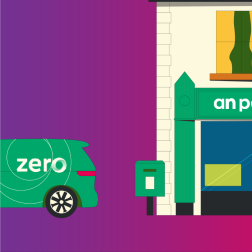- 2 mins read time
- Published: 24th June 2020
Oxfam Shops and Sustainability

Through our all-island network of shops, we are proud to offer solutions to ‘throwaway fashion’, encouraging people to donate pre-loved items and reduce the amount of clothes that end up in Irish landfills – as well as extending the lifecycle of clothes and raising awareness about fast fashion.
People have been reusing and reselling clothes with Oxfam Ireland since it opened its first shop in 1971, and since then we have always worked to maximise the value of everything we are given and minimise waste.
Although there is a growing sustainable fashion movement in Ireland, it is not usually the industry people think of when considering climate villains or big polluters.
Fast fashion clothes are produced in high volume which means a high cost to the planet: According to the UNFCCC, the textiles industry accounts for more carbon emissions than international aviation and shipping combined – it is the world’s second most polluting industry after oil and accounts for approximately eight percent of global greenhouse gas emissions. In addition, clothes are produced cheaply which often means low wages and poor working conditions for garment workers.
Overproduction is part of the problem. Shared Cloth published a report that states 20 items per person are produced every year (150 billion garments), and 30 percent of them are never sold. On top of that, cheap production and plummeting prices means the items we buy often end up in landfill before they should.
According to Re-dress, 225,000 tonnes of textiles are dumped in Ireland each year – that’s the equivalent of over 5,000 44 tonne lorry loads. This is having a devastating impact on our planet and people. We know that the world’s poorest, who did the least to cause climate change, are most affected, through droughts, floods and extreme weather events.
In addition, clothes can take up to 200 years to decompose whereas recycling the 225,000 tonnes of textiles would reduce greenhouse gas emissions by over 300,000 tonnes per year – the equivalent of taking 50,000 cars off the roads.
Oxfam staff sort clothing into different grades depending on garment type, condition, style and fabric. The clothing donated is then used in the most suitable market via several different routes, including:
- Oxfam high street shop – most of the donated clothing is sold in the shop it was donated too as we believe in local economy.
- Online platforms such as Thriftify
- Designers who restyle garments and reuse fabrics in their collections – for example, we provide denim to a company that make them into really cool tote bags
The low-grade items not sold as clothing are sold in bulk to recycling reprocessing companies in Ireland where it’s used, for example, as mattress filler, carpet underlay, upholstery or car sound insulation. Unsaleable items which are too soiled or damaged to be recycled are incinerated by a textile recycler.
We also work with retailers and big brands, encouraging them to donate their end of line or excess stock instead of sending it to landfill – a more sustainable solution for people and planet.
So, as you can see, your donations hold a lot of value and power. Every garment or item donated to us raises money to fight inequality around the world and supports our mission to beat poverty globally.




